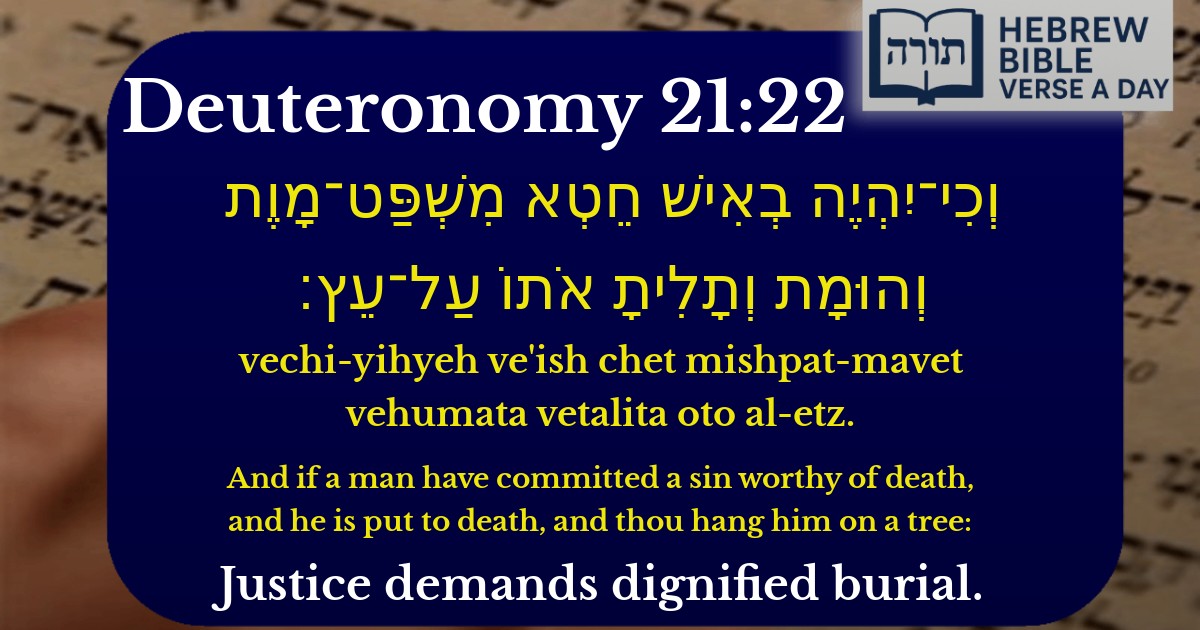Frequently Asked Questions
Q: What does Deuteronomy 21:22 mean when it talks about hanging someone on a tree?
A: Deuteronomy 21:22 refers to the ancient Jewish law where a person executed for certain severe sins would be publicly displayed by hanging on a wooden post (עֵץ - 'etz') as a deterrent. However, the Torah immediately commands in the next verse (Deuteronomy 21:23) that the body must be buried before nightfall, showing respect for human dignity even after death.
Q: Why is it important to bury the body before nightfall according to this verse?
A: The Torah commands burial before nightfall (Deuteronomy 21:23) to maintain the dignity of the deceased, as leaving a body exposed is considered degrading. Rashi explains that delaying burial would be an affront to G-d, since humans are created in G-d's image (B'tzelem Elokim). This teaches us the fundamental Jewish value of respecting all human beings, even after death.
Q: What types of sins would warrant this punishment in Torah law?
A: The Talmud (Sanhedrin 46b) explains that this form of post-execution display was reserved for only two specific sins: blasphemy (cursing G-d's name) and idolatry. These were considered particularly severe because they undermine the foundation of the covenant between G-d and the Jewish people. However, the Talmud emphasizes how rare these cases were in practice.
Q: How does this verse apply to Jewish values today?
A: While we no longer practice this form of punishment, this verse teaches enduring Jewish values: 1) The seriousness with which Judaism views sins that undermine our relationship with G-d, 2) The importance of maintaining human dignity even when administering justice, and 3) The obligation to bury the dead promptly - a principle that guides Jewish burial practices (kavod hamet) to this day.
Q: Why does the Torah specify hanging on a 'tree' (etz)?
A: The term 'tree' (עֵץ) here refers to any wooden object or post, not necessarily a living tree. Rambam (Hilchos Sanhedrin 15:7) explains this was a wooden beam used for temporary public display. The choice of wood (rather than stone or metal) may symbolize how this was meant as a temporary measure (until burial), not a permanent monument of shame.


Context and General Meaning
The verse (Devarim 21:22) discusses the halachic procedure for executing a person guilty of a capital crime and subsequently hanging the body on a tree. According to Orthodox Jewish tradition, this is not a form of execution itself but rather a post-mortem display for certain severe sins, as elaborated in the Talmud and classical commentaries.
Rashi's Explanation
Rashi (Devarim 21:22) clarifies that the hanging is not the method of execution but occurs after the condemned has already been put to death by stoning (the primary method of execution in Jewish law). He cites the Mishnah (Sanhedrin 6:4), which states that only blasphemers and idolaters were hanged in this manner, emphasizing that this was a rare and specific punishment.
Rambam's Halachic Perspective
Rambam (Hilchos Sanhedrin 15:1) codifies the law based on the Talmud (Sanhedrin 46b), explaining that hanging was a temporary measure to publicly disgrace those guilty of particularly grievous sins. The body was not left hanging overnight, as the next verse (Devarim 21:23) commands burial on the same day, reflecting the principle of human dignity even after death.
Midrashic Insights
Talmudic Discussion
The Talmud (Sanhedrin 46b) emphasizes that the hanging is not an act of cruelty but a means to fulfill the biblical command while maintaining respect for the deceased. The body is to be taken down before nightfall, and delaying burial is considered a disgrace to G-d, as man is created in His image (Bereishis 1:27).
Practical Application in Halacha
In practice, this form of punishment was exceedingly rare, as capital cases required stringent evidentiary standards and warnings (Sanhedrin 4:1). The Talmud (Makkos 7a) notes that a Sanhedrin that executed once in seventy years was called "destructive," highlighting Judaism's overarching value for life and restraint in capital punishment.